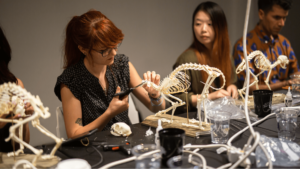Events are an important fundraising tool for non-profit organisations, and millennials in particular adore live events for the feeling of connection they inspire. That’s why thousands of non-profit organisations rely on Eventbrite to promote their events, raise more funds, and sell more tickets. Check out our 10-step guide to planning a unique charity event or fundraiser that will exceed goals and expectations.
 1. Define your cause and set a fundraising goal
1. Define your cause and set a fundraising goal
When determining your event objectives, ask yourself:
- Why are you raising the money? This will help you create an effective promotional strategy and operational plan. All other decisions cascade from this mission statement. Remember that donations are not the only way to support a cause; your event will also raise awareness and catalyse networking.
- How much money are you trying to raise? Think about setting a goal that’s achievable while still being aspirational enough to excite your guests. Consider different avenues like ticket sales, donations, live auctions, silent auctions, and crowdfunding to maximise your reach.
- Who will the money benefit? Think about who will ultimately benefit from the money you’re raising and what that money will do for them. Potential donors like to hear exactly what their donations are going to do, and incorporating this information into your marketing materials will help raise awareness for your cause.
2. Create a realistic event budget
Determine the costs of holding an event against the potential funds expected to be raised. A budget will help keep your costs in perspective and get more for your money. Make sure it includes every single detail – from the venue to the catering to the parking valets. Keep an open mind and always leave a little room in your budget for the unpredictable. It’s better to exceed your goals than have them eaten into by unforeseen expenses.
Explore the opportunities for cash sponsorship, which is an important contribution to a fundraising event. Investigate appropriate contacts that may show interest in the event and would be willing to contribute. Does the business have a connection to the charity? How does it benefit them? These are all things to consider when trying to get them on board.
Tip: Check our event budget template to master your event financials and keep more money for your cause.
3. Target the perfect charity event audience
Dial in on your audience. Would a gala dinner or a golf day be a better fit for the charity you’re working with? Does your charity appeal to a particular generation or interest? Is it a local fundraiser or a universal cause? Is it going to be an invite-only, black-tie affair, or will you reach out to the general public? Determine your audience and your marketing and outreach plan will follow.
4. Find the perfect venue for your fundraiser
Location, location, location
Research, visit, and assess a variety of locations in order to find one that best suits your event. Your choice of venue significantly impacts attendance, creates the atmosphere of the event, and contributes to the theme. Don’t forget to look beyond just catering halls and convention centres when choosing an event venue. Many charity events are held in alternative spaces like airport hangars, country barns, or rooftop gardens.
Stay within your budget
While location is key, it is just as important to consider what the venue has to offer in terms of discounts or special promotions in order to assist with the event’s fundraising efforts. Carrying out a thorough budget review will help determine if anything needs to be sacrificed in order to meet the minimum spend while still maintaining effective and successful fundraising.
Keep accessibility in mind
Event safety and accessibility aren’t just compliance issues. Making your event more accessible widens your reach and makes your attendees feel welcome. Most importantly, it creates an environment of inclusivity, diversity, and positivity – important ingredients for a non-profit fundraiser.
Start by making sure your event has enough space set aside for people using wheelchairs or who are hard of hearing, have visual disabilities, or will require room for a service animal. Also be sure to use accessibility signage with large, legible typefaces at multiple heights.
Key questions to answer during your venue search:
- Will it accommodate the number of people you hope will attend?
- How much will it cost?
- Does the venue offer a discount for non-profit events?
- What is included in the price? Ask about catering, seating, staffing, décor, and photographers
- Does the venue have all of the power sources you need?
- Does the venue provide audio or visual equipment?
- Are there any accessibility issues?
- Is the venue available for your preferred date?
Tip: For more ideas on creating an accessible event, check out our guide.
 5. Establish a theme for your charity event
5. Establish a theme for your charity event
People are excited to support a cause, but they also want to have a great time. Millennials in particular are “the experiences generation.” They love spending money creating memories, and the theme of your event should help tease what awaits. Remember: “Raise Money” is not a theme. However, for example, “Singles’ Charity Night” is. To inspire donors and attendees alike, come up with a fun and unique event they’ll be excited to attend (and recap on their social media feeds). Include an attraction such as a special guest, musical act, or pop-up shop that will get the attention of a broader audience and give people something to talk about. To help you brainstorm, ask yourself these questions:
- How will you reach your objective? Do you have merchandise to sell? Will you be providing entertainment or activities for which you can charge admission?
- Who is your target audience? What demographics are most likely to engage with your cause? Would they be more inclined to take part in a 5K charity race, attend a fashion show, or enjoy a concert?
Consider both your cause and your audience. What would your target audience find entertaining that would be on point with your cause? If you’re not feeling creative, read our roundup of unique fundraising ideas.
6. Find charitable event sponsors
To find sponsors for your event, start with your inner circle and work your way outward. Target businesses with which you are already engaged. If your attendees are their prospects or customers too, it’s mutually beneficial for them to become a sponsor.
Next, check in with your board members and other stakeholders to see if they might have sponsorship suggestions. Finally, reach out to companies that are sponsoring other non-profit events in your area.
7. Market your charity event strategically
Once the details are nailed down, it’s time to get the word out and build excitement for your charity event. For a charity event or fundraiser, spreading the word is crucial – it directly affects your ability to meet and exceed your goals. Create a strategy that covers the digital channels you’ll employ: email marketing, social media marketing, and more. Share your charity event press release with as many local media outlets as possible.
- Traditional marketing: Create flyers to attract local attention. Distribute them widely to generate the maximum buzz.
- Email marketing: Eventbrite Boost offers simple and powerful tools to market your event via email. Start sending emails as soon as you know your event’s on-sale date. Reach out to past attendees first or, if it’s a brand new event, share the announcement with your mailing list to start generating excitement. Do a retargeting campaign for page visitors who don’t complete the registration. Create a sense of urgency by reminding them of when the sale ends, or that the event is almost sold out.
- Social media: Social media is one of your biggest allies here. Millennials love to express themselves online. Nearly half of them admit to attending live events just to have something to share on social. Give them something to share by providing rich online content. Utilise video clips and images and ensure that your posts are shareable, so your attendees can easily pass them along to their followers. Consider incentives, such as a ticket giveaway or donation matching program, when people share your cause online. Eventbrite Boost makes it easy to create, launch, and target social media ads on Facebook and Instagram to potential attendees.
8. Decide how you’ll accept donations
Offer more than one donation method in order to maximise your fundraising. Start with an online event ticketing platform like Eventbrite, which can take digital and mobile payments in advance and help you track them. Eventbrite offers full-service payment processing with enhanced options like reserved seating and direct deposits into your bank account. For at-the-door sales, choose a ticketing provider that provides an app to expedite last-minute sales. For virtual charity events and live events alike, make it easy to give by providing a PayPal account that will accept donations. You can also set up a donation option on your event page for quick and easy digital giving, so people can donate even if they can’t attend.
 9. Recruit, train, and manage your volunteers
9. Recruit, train, and manage your volunteers
Successful charity events run on the enthusiasm and support of their volunteers. The best place to look for volunteers is among your attendees, including people on your mailing list or who have registered in the past. It’s important to choose reliable people who will show up and charm donors. Use these three tactics to weed out unreliable volunteers and make sure your efforts pay off.
- Pre-qualify volunteers: Make sure you’re not just finding people who want to volunteer, but those who can actually do the job. When they sign up, ask potential volunteers what other events they’ve volunteered to staff, what their role was, and why they want to help at your event.
- Create an orientation program: Whether the event is in person or online, give an overview of what volunteers should expect on event day and what will be expected of them.
- Designate a volunteer lead: Your volunteer lead will be responsible for getting volunteers up to speed on everything, from logistics to onsite tech. Build in ample time to train volunteers so that there is no confusion or last-minute stress on the day of the event.
Tip: Discover more non-profit event planning tips on managing your volunteers.
10. Automate your charity event technology
Most fundraising and charity events don’t have enormous budgets, so any way you can make your operations or marketing more efficient will lower your costs. For instance, automated emails can give attendees detailed event information upon ticket purchase. Social media management tools can consolidate your posting and tracking efforts across platforms. These are just a couple of the automation possibilities available through Eventbrite Boost.
Ready for your next fundraiser?
Eventbrite makes it easy to create an event page and promote ticket sales on social media. Get started on planning a charity event today with our intuitive platform.






